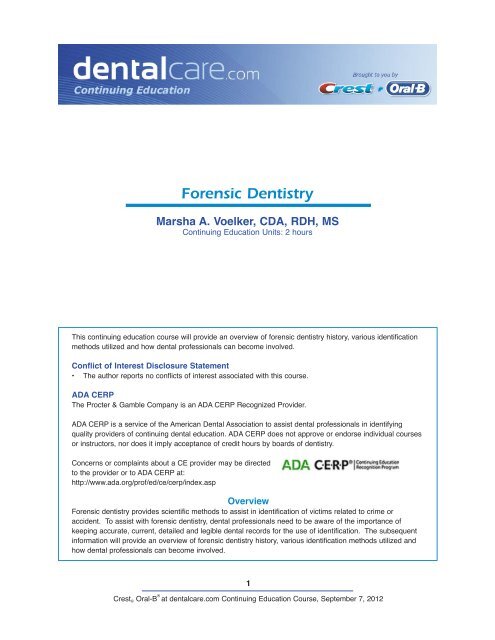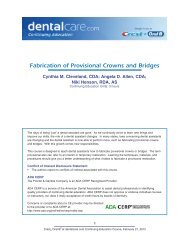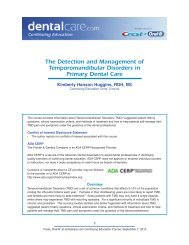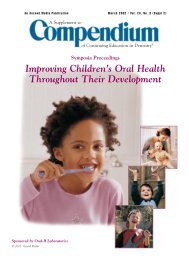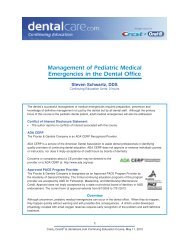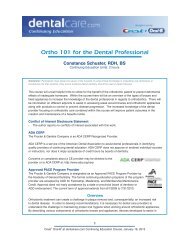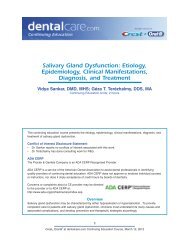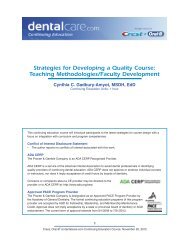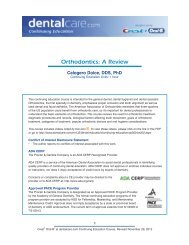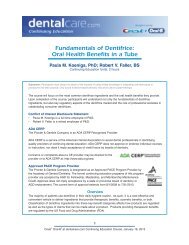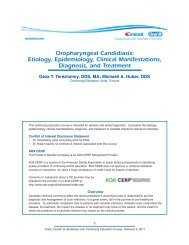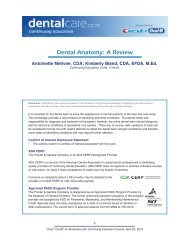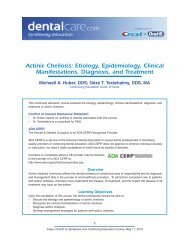CE 201 - Forensic Dentistry - DentalCare.com
CE 201 - Forensic Dentistry - DentalCare.com
CE 201 - Forensic Dentistry - DentalCare.com
You also want an ePaper? Increase the reach of your titles
YUMPU automatically turns print PDFs into web optimized ePapers that Google loves.
<strong>Forensic</strong> <strong>Dentistry</strong><br />
Marsha A. Voelker, CDA, RDH, MS<br />
Continuing Education Units: 2 hours<br />
This continuing education course will provide an overview of forensic dentistry history, various identification<br />
methods utilized and how dental professionals can be<strong>com</strong>e involved.<br />
Conflict of Interest Disclosure Statement<br />
• The author reports no conflicts of interest associated with this course.<br />
ADA <strong>CE</strong>RP<br />
The Procter & Gamble Company is an ADA <strong>CE</strong>RP Recognized Provider.<br />
ADA <strong>CE</strong>RP is a service of the American Dental Association to assist dental professionals in identifying<br />
quality providers of continuing dental education. ADA <strong>CE</strong>RP does not approve or endorse individual courses<br />
or instructors, nor does it imply acceptance of credit hours by boards of dentistry.<br />
Concerns or <strong>com</strong>plaints about a <strong>CE</strong> provider may be directed<br />
to the provider or to ADA <strong>CE</strong>RP at:<br />
http://www.ada.org/prof/ed/ce/cerp/index.asp<br />
Overview<br />
<strong>Forensic</strong> dentistry provides scientific methods to assist in identification of victims related to crime or<br />
accident. To assist with forensic dentistry, dental professionals need to be aware of the importance of<br />
keeping accurate, current, detailed and legible dental records for the use of identification. The subsequent<br />
information will provide an overview of forensic dentistry history, various identification methods utilized and<br />
how dental professionals can be<strong>com</strong>e involved.<br />
1<br />
Crest ® Oral-B ®<br />
at dentalcare.<strong>com</strong> Continuing Education Course, September 7, <strong>201</strong>2
Learning Objectives<br />
Upon <strong>com</strong>pletion of this course, the dental professional should be able to:<br />
• Discuss forensic dentistry history.<br />
• Recognize and describe identification methods utilized in forensic dentistry.<br />
• Explain and determine what constitutes a mass fatality and be aware of federal, regional, and state<br />
response teams.<br />
• Discuss the various training requirements and opportunities in forensic dentistry.<br />
• Describe various ways for the dental professional to be<strong>com</strong>e involved in forensic dentistry.<br />
Course Contents<br />
• Introduction<br />
• <strong>Forensic</strong> <strong>Dentistry</strong> History<br />
• Identification and Methods Utilized<br />
• <strong>Forensic</strong> <strong>Dentistry</strong> Areas<br />
Bite Marks<br />
Abuse<br />
Mass Fatality<br />
• Education and Training<br />
• Dental Professional Involvement Opportunities<br />
• Conclusion<br />
• Course Test<br />
• References<br />
• About the Authors<br />
Introduction<br />
After mass fatalities such as the events of<br />
September 11, 2001, Hurricane Katrina, and<br />
the Oklahoma City Bombings, identification of<br />
individuals through dental records has be<strong>com</strong>e<br />
increasingly necessary. <strong>Forensic</strong> dentistry is one<br />
mechanism to aid in the identification of unknown<br />
victims of mass casualty and criminal incidents.<br />
Dental forensics and forensic odontologies<br />
are terms used interchangeably and they are<br />
described as the management, examination,<br />
evaluation and presentation of dental evidence<br />
in criminal or civil proceedings, in the interest<br />
of justice. 1 There is a vast history of various<br />
documented ways that dental evidence and<br />
records have been utilized to identify victims or<br />
convict murderers.<br />
<strong>Forensic</strong> <strong>Dentistry</strong> History<br />
The first forensic dentist in the United States was<br />
Paul Revere who was known for the identification<br />
of fallen revolutionary soldiers. 2-4 Dr. Joseph<br />
Warren, who suffered a severe head trauma<br />
during the war, was identified by the small denture<br />
that Paul Revere had fabricated for him. 4 Through<br />
this identification, it was made possible for Dr.<br />
Warren to be buried with full military honors. 2,3<br />
2<br />
Dr. George Parkman was a respected professor<br />
at Harvard University who also dealt with real<br />
estate and lending money. 4 John Webster, a<br />
colleague of his at Harvard, who was a chemist,<br />
owed Dr. Parkman a considerable amount of<br />
money. 4 One evening, Dr. Parkman failed to<br />
return home from dinner on November 23, 1849.<br />
John Webster’s laboratory was searched and a<br />
tea chest containing human remains was found.<br />
In the furnace, fragments of the maxillary jaw<br />
were discovered. 4,5 At the trial for John Webster,<br />
Dr. Nathan Cooley Keep, Dr. Parkman’s dentist,<br />
identified the teeth as part of the maxillary and<br />
mandibular dentures he made three years earlier<br />
for the victim. This was the first time dental<br />
evidence was used to convict a murderer. This<br />
case is also a great example of how expert<br />
testimony was used in court. 5<br />
After the shooting of President Lincoln on April<br />
14, 1865, John Wilkes Booth escaped and hid in<br />
a barn on a farm in Virginia. 4,6 The United States<br />
Calvary found him there on April 26, 1865 and<br />
burned the barn. 4,6 John Wilkes Booth exited the<br />
barn and was shot and killed. 6 However there was<br />
rumor that Mr. Booth had escaped. Therefore in<br />
1893, the body was disinterred and examined to<br />
verify that it was John Wilkes Booth. 4,6 The family<br />
could not perform a visual identification, but the<br />
family dentist was able to recognize his work as<br />
well as a peculiar formation of the jaw he had<br />
noted in his records during a dental visit for the<br />
placement of a filling. 6<br />
Dr. Oscar Amoëdo returned to Cuba in 1889 after<br />
studying at New York Dental College. He was<br />
then sent as a delegate to the International Dental<br />
Congress in Paris in 1890. 4 He decided to stay in<br />
Paris and became a dental instructor and teacher,<br />
eventually be<strong>com</strong>ing a full professor. While in<br />
Paris, he wrote 120 scientific articles. A tragic fire<br />
at a charity event stimulated his interest in dental<br />
Crest ® Oral-B ®<br />
at dentalcare.<strong>com</strong> Continuing Education Course, September 7, <strong>201</strong>2
identification and the field of forensic odontology. 7<br />
While he was not involved with the identification<br />
of the victims from the fire, he knew many of the<br />
victims who survived and interviewed them. His<br />
accounts of the fire were presented in a paper at<br />
the International Medical Congress of Moscow<br />
and were published in English in 1897. 7 Dr.<br />
Amoëdo wrote a thesis entitled “L’Art Dentaire en<br />
Medicine Legale,” 8 which earned him a doctorate<br />
and served as the basis of his book by the same<br />
name published in 1898. 8 The book he wrote<br />
was the first <strong>com</strong>prehensive text on forensic<br />
odontology and he is considered by many to be<br />
the “Father of <strong>Forensic</strong> Odontology.” 4,8<br />
After the end of World War II, there were rumors<br />
Adolf Hitler had escaped with his wife Eva Braun. 4<br />
Actually they had died together in 1945; however<br />
their bodies had been burned and then buried by<br />
Russian soldiers. 4 Due to lack of ante-mortem<br />
and post-mortem records, it was a challenge to<br />
dispel the rumors they were still alive. Finally<br />
pieces of Hitler’s mandible were found that<br />
revealed remnants of a bridge as well as unusual<br />
forms of reconstruction to the mandible with<br />
evidence of periodontal disease. 9 Adolf Hitler’s<br />
identity was confirmed when the work matched<br />
the records kept by his dentist, Hugo Blaschke. 9<br />
Several years after the assassination of John<br />
F. Kennedy, an English author named Michael<br />
Eddowes began raising suspicion concerning the<br />
identification of Lee Harvey Oswald. 4 He believed<br />
the body buried in 1963 in Oswald’s grave was<br />
a Russian spy. 4 Therefore, to set the record<br />
straight, the body was exhumed and positive<br />
identification of Oswald was made on October 4,<br />
1981 with military ante-mortem dental records. 10<br />
In July of 1979, Theodore “Ted” Bundy was<br />
convicted of murder. This may have been the<br />
most widely publicized case that involved bite<br />
mark evidence. The exhaustive and specific<br />
Table 1. Reasons for Identification of Human Remains.<br />
3<br />
nature of bite registries is to thank, at least in part,<br />
for Bundy’s incarceration. Ted Bundy was one of<br />
the most notorious serial killers in United States<br />
History. He could have been responsible for the<br />
deaths of as many as 36 young women from<br />
Florida to the state of Washington. 11<br />
Identification and Methods Utilized<br />
Dental records are used to aid in the identification<br />
of individuals who are victims of criminal acts,<br />
murder investigations, mass fatalities or missing<br />
persons. 1 The confirmation of a decedent’s<br />
identity is important for several reasons (Table 1).<br />
One of the most important is bringing closure to<br />
the immediate family members when tragic or<br />
unexpected events occur. 4 Another reason is<br />
for legal settlements of estates where a death<br />
certificate is needed. 4 In order for a death<br />
certificate to be issued, a confirmation of identity<br />
is needed. 4 This is why dental identification<br />
assumes a primary role in the identification<br />
of remains when postmortem changes occur,<br />
traumatic tissue injury occurs or there is a lack<br />
of fingerprint records which invalidates the use<br />
of visual or fingerprinted evidence. 1 Identification<br />
is crucial when the deceased is de<strong>com</strong>posed,<br />
burned, dismembered, or skeletonized. 1 The<br />
advantage of dental evidence is that like other<br />
hard tissues, it is often preserved after death<br />
(post-mortem). 1<br />
The evidence that can be derived from teeth is<br />
the age estimation (i.e., children, adolescents,<br />
adults) and identification of the person to whom<br />
the teeth belong. This is done using ante-mortem<br />
(prior to death) dental records, radiographs 12<br />
and photographs and by <strong>com</strong>paring them to<br />
post-mortem records. It is important for dental<br />
professionals to document information in the<br />
ante-mortem dental record clearly, correctly, and<br />
specifically. <strong>Forensic</strong> dentistry starts with dental<br />
professionals and so, dental professionals are<br />
encouraged when documenting to utilize universal<br />
Crest ® Oral-B ®<br />
at dentalcare.<strong>com</strong> Continuing Education Course, September 7, <strong>201</strong>2
abbreviations when needed, and to be detailed<br />
about the procedures conducted on patients. A<br />
person’s teeth change throughout life and the<br />
<strong>com</strong>bination of decayed, missing and filled teeth<br />
is measurable and <strong>com</strong>parable at any fixed<br />
point in time. Therefore, quality radiographs<br />
and accurate charting are the FIRST steps in<br />
providing a positive identification.<br />
Teeth have the ability to survive de<strong>com</strong>position<br />
and withstand extreme temperature changes,<br />
which is why dental evidence <strong>com</strong>parison is one<br />
of the most dependable and reliable methods<br />
of identification. 4 This is made possible by<br />
<strong>com</strong>paring features of an unknown individual<br />
(post-mortem dental records) with a known<br />
individual (ante-mortem dental records). For this<br />
reason, it is extremely important an accurate and<br />
detailed evaluation of the unknown individual<br />
is documented to provide the best possibility<br />
of successful <strong>com</strong>parison with ante-mortem<br />
records. 4 The following is collected for postmortem<br />
documentation: photographs (digital<br />
or film based) which provide the ability to view<br />
specific features without having to review the<br />
body, radiographs (full mouth series) (Figure 1),<br />
and a <strong>com</strong>plete dental record for post-mortem<br />
and ante-mortem paperwork (Figures 2A & 2B). 16<br />
The primary goal of post-mortem dental records<br />
is to locate, identify and document anatomical<br />
structures, dental restorations and dental<br />
appliances that will assist in the <strong>com</strong>parison<br />
process. 4 The more information documented<br />
from the post-mortem examination, the better the<br />
possibility for successful <strong>com</strong>parison. 4<br />
Figure 1. Comparison of Post-mortem (PM) with Ante-mortem (AM) Radiographs.<br />
Radiographs courtesy of Dr. McCunniff.<br />
4<br />
There are three categories examined when<br />
<strong>com</strong>paring dental records (ante-mortem with postmortem)<br />
for identification, which are the teeth,<br />
periodontal tissue, and anatomical features. 13<br />
When conducting a <strong>com</strong>parison regarding teeth,<br />
it is important to determine if they are present<br />
(erupted, unerupted, impacted), congenitally<br />
missing or lost ante-mortem/post-mortem, tooth<br />
type (permanent, deciduous, mixed, retained<br />
primary, supernumerary), what the tooth positions<br />
are, crown morphology and pathology, and root<br />
morphology. Pulp chamber and root morphology<br />
may also be considered valuable information in<br />
identification. The pulp chamber can be used to<br />
distinguish approximate age of the individual, since<br />
the chamber size varies from children to adult<br />
teeth. The root morphology along with the pulp<br />
chambers will assist in determining whether the<br />
tooth is from the maxillary or mandibular arch, and<br />
distinguishing if it is an anterior or posterior tooth. 14<br />
Incidents such as plane crashes and explosions<br />
can damage the coronal surface of the tooth. A<br />
positive identification is still possible by <strong>com</strong>paring<br />
the pulp chamber and root morphology. 12 The root<br />
surfaces of teeth have unique shapes and bends<br />
that just may be the key to a positive identification.<br />
Other factors to look for when conducting a<br />
<strong>com</strong>parison are the periodontal tissues in regards<br />
to gingival morphology and pathology, periodontal<br />
ligament morphology and pathology, and the<br />
alveolar process and lamina dura. In addition<br />
to anatomical structures such as the maxillary<br />
sinus, anterior nasal spine, mandibular canal,<br />
coronoid condylar processes, temporomandibular<br />
Crest ® Oral-B ®<br />
at dentalcare.<strong>com</strong> Continuing Education Course, September 7, <strong>201</strong>2
Figure 2A. Post-mortem Dental Record Documentation (CAPMI System).<br />
Image source: http://medical.tpub.<strong>com</strong>/14275/css/14275_246.htm<br />
5<br />
Crest ® Oral-B ®<br />
at dentalcare.<strong>com</strong> Continuing Education Course, September 7, <strong>201</strong>2
Figure 2B. Ante-mortem Dental Record Documentation (CAPMI System).<br />
Image source: http://medical.tpub.<strong>com</strong>/14275/css/14275_249.htm<br />
6<br />
Crest ® Oral-B ®<br />
at dentalcare.<strong>com</strong> Continuing Education Course, September 7, <strong>201</strong>2
joint (TMJ), and other pathologies (developmental<br />
cysts, salivary gland pathology, trauma, evidence<br />
of surgery, metabolic bone disease, reactive/<br />
neoplastic, focal or diffuse radiopacities). 13,15<br />
There are <strong>com</strong>puter identification databases<br />
such as WinID© or NCIC that are used today<br />
to <strong>com</strong>pare ante-mortem and post-mortem data<br />
in the identification of deceased or missing<br />
individuals. WinID© is a dental <strong>com</strong>puter system<br />
that matches missing persons to unidentified<br />
human remains. WinID© makes use of dental and<br />
anthropometric characteristics to rank possible<br />
matches. 16 WinID© is used by forensic dentists,<br />
forensic odontologists, pathologists, coroners,<br />
medical examiners, forensic anthropologists and<br />
those in the law enforcement and criminal justice<br />
systems to identify the unknown. 16 DMORT, which<br />
is a federal response team, includes dental team<br />
members that are deployed to aid in identifying<br />
victims. 17 These teams are currently utilizing<br />
WinID© for identification(s) as well as a digital<br />
imaging software just for forensic identification that<br />
can interact with WinID© entitled DEXIS <strong>Forensic</strong>.<br />
DEXIS <strong>Forensic</strong> has a <strong>com</strong>puterized receiver that<br />
is inserted into a laptop <strong>com</strong>puter. The system<br />
utilizes charge coupled device (CCD) sensors that<br />
are placed in the victim and exposed to radiation<br />
providing an instant radiographic image on the<br />
<strong>com</strong>puter screen. In addition, DEXIS <strong>Forensic</strong> has<br />
the capability to scan existing film-based dental<br />
records into WinID© for electronic transfer and<br />
<strong>com</strong>parison. This capability is utilized for inputting<br />
ante-mortem records into WinID©. WinID© was<br />
used for the first time to assist in the identification<br />
of Hurricane Katrina victims in the American<br />
Southeast in 2005. 17<br />
The Federal Bureau of Investigation also has<br />
a <strong>com</strong>puter database called National Crime<br />
Information Center (NCIC) through the Criminal<br />
Justice Information Services (CJIS) Division. 4,18<br />
The purpose for maintaining the NCIC system is to<br />
provide a <strong>com</strong>puterized database for ready access<br />
by a criminal justice agency making an inquiry and<br />
for prompt disclosure of information in the system<br />
from other criminal justice agencies about missing<br />
or unidentified persons, crimes and criminals. 4,18<br />
This information assists authorized agencies<br />
in criminal justice and related law enforcement<br />
objectives such as apprehending fugitives, locating<br />
missing persons, locating and returning stolen<br />
7<br />
property, as well as in the protection of the law<br />
enforcement officers encountering the individuals<br />
described in the system. 4,18<br />
The National Institute of Justice in 2007 began<br />
funding the National Missing and Unidentified<br />
Person Systems (NamUs). 4 The NamUs system<br />
has two databases, one for unidentified decedents<br />
and the other for known missing persons data.<br />
In 2009, the NamUs system established a link<br />
between the two databases that allowed the<br />
<strong>com</strong>parison of unidentified remains to known<br />
missing persons. 4 The database is searchable<br />
and accessible by medical examiners, forensic<br />
scientists, law enforcement, and the general<br />
public. 4<br />
<strong>Forensic</strong> <strong>Dentistry</strong> Areas<br />
There are several areas of specialty with forensic<br />
dentistry, which include the assessment of bitemark<br />
injuries, assessment of cases of abuse (child,<br />
domestic partner, or family), identification of found<br />
human remains and identification in mass fatalities.<br />
Bite Marks<br />
The use of bite mark evidence began around 1870<br />
with the Ohio vs. Robinson case. 19,20 The case<br />
involved A.I. Robinson, a well-regarded member of<br />
his <strong>com</strong>munity, who was suspected of murdering<br />
his mistress. There were five distinct bite marks<br />
located on the victim’s arm which revealed five<br />
maxillary anterior teeth. 21 Robinson happened to<br />
only have five maxillary anterior teeth, which Dr.<br />
Taft, a dentist, testified in court that Robinson’s<br />
dentition matched the bite marks from the victim. 21<br />
A bite mark is known as the registration of the<br />
cutting edges of teeth on a substance caused by<br />
a jaw closing.22 The scientific premise regarding<br />
bite mark analysis is stemmed from the fact that<br />
the human dentition is not identical from person to<br />
person. 20 Bite marks are as specific to a person<br />
as DNA or fingerprint analyses, similarly, no two<br />
individuals will have the exact same dentition in<br />
regards to shape, size and alignment of teeth. 20<br />
Bite marks are either left on the victim (by the<br />
attacker), on the perpetrator (by the victim of an<br />
attack) or an inanimate object found at the crime<br />
scene. 21 Human bite marks on victims are most<br />
often found on the skin and soft tissue areas of<br />
all parts of the body. 21 Area bite marks on female<br />
Crest ® Oral-B ®<br />
at dentalcare.<strong>com</strong> Continuing Education Course, September 7, <strong>201</strong>2
victims are most often found on the breasts and<br />
legs produced during sexual attacks. 21 On males<br />
the bite marks are <strong>com</strong>monly seen on the arms<br />
and shoulders. 23,24 When a person is in defensive<br />
circumstances, such as when the arms are held<br />
up to ward off an attacker, the arms and hands<br />
are often bitten. 13 Bite marks are often found on<br />
children who are abused. 19,22<br />
The duration of a bite mark is determined by the<br />
magnitude and how long the victim had been<br />
bitten. 22 Human bite marks are described as an<br />
elliptical or circular injury that records the specific<br />
characteristics of the teeth. 25 The bite mark may<br />
be in the shape of a doughnut with characteristics<br />
recorded around the perimeter of the mark. 13 Also<br />
it may be <strong>com</strong>posed of two U-shaped arches<br />
that are separated at their bases by an open<br />
space. Typically the diameter of the injury is<br />
from 25-40mm. 13 Often the injury has a central<br />
area of bruising seen within the bite mark. 13 This<br />
is caused by pressure from the teeth as they<br />
<strong>com</strong>press the tissue inward from the perimeter of<br />
the mark. 13<br />
Guidelines have been established for bite mark<br />
analyses by the American Board of <strong>Forensic</strong><br />
Odontology (ABFO) (Table 2) for the ABFO<br />
Guidelines. 21,26 When collecting dental evidence,<br />
a description of the bite mark in regards to<br />
demographics, location, shape, size, color, type<br />
of injury and any other information needs to<br />
8<br />
be recorded. 21,25,26 The collection of evidence<br />
from the victim includes photographs, salivary<br />
swabbing, impressions and tissue samples. 21,25,26<br />
Even collection of evidence from the suspect(s) is<br />
needed, which includes history, photos, extraoral<br />
examination, intraoral examination, impressions,<br />
sample bites and study casts. 21<br />
Upon collection of dental evidence, the forensic<br />
odontologist analyzes and <strong>com</strong>pares the bite<br />
marks. 21,26,27 Studies have been performed in<br />
an attempt to find the simplest, most efficient<br />
and most reliable way of analyzing bite marks. 27<br />
Early forensic investigators analyzed marks left<br />
by dental casts in wax, clear overlays, and other<br />
mediums. 27 Others attempted to simulate the<br />
consistency of human tissue by using articulated<br />
dental models to “bite” baker’s dough and sponge<br />
rubber. 28 The ABFO has guidelines established<br />
for bite mark methodology to preserve bite mark<br />
evidence. 29,30 Considerations that need to be<br />
made when photographing and documenting the<br />
bite site are lighting and the utilization of a scale<br />
in the photo to provide an accurate account of the<br />
bite site size. 13,25,26,29 The methods for <strong>com</strong>paring<br />
bite mark evidence are the use of overlays, test<br />
bite media, <strong>com</strong>parison techniques and technical<br />
aids employed for analysis. 13,21,29<br />
There are factors that may affect the accuracy<br />
of bite mark identification which include timedependent<br />
changes of the bite mark on living<br />
Table 2. ABFO Guidelines for the Collection of Victim Evidence. 13,29<br />
Crest ® Oral-B ®<br />
at dentalcare.<strong>com</strong> Continuing Education Course, September 7, <strong>201</strong>2
Figure 3. Dr. Richard Souviron presents evidence at Ted Bundy’s appeal<br />
trial - Tallahassee, Florida.<br />
Mark Foley - Photographer<br />
Source: http://www.floridamemory.<strong>com</strong>/items/show/133904<br />
bodies, effects of where the bite mark was<br />
found, damage on soft tissue, and similarities in<br />
dentition among individuals. 27 Elasticity and the<br />
inflammatory process of human tissue hinder the<br />
identification process of bite mark registration. 27<br />
Placement of the limb in the exact position when<br />
the attack occurred is necessary to recreate the<br />
correct bite relationship; this may not always be<br />
known in the case of a decedent. 27<br />
In regards to famous bite mark cases, Ted<br />
Bundy the serial killer would be the one that<br />
<strong>com</strong>es to mind. Dr. Richard Souviron was the<br />
forensic dentist, who was requested to <strong>com</strong>e to<br />
Tallahassee, Florida to examine evidence that<br />
had been discovered on the body of one of the<br />
victims from the Chi Omega sorority house in<br />
January of 1978. 23 Dr. Souviron, by accepting a<br />
part in the case, became part of the legal process<br />
regarding the case. 20 Therefore, Dr. Souviron<br />
was responsible for thorough documentation of<br />
the evidence. 20 He found, upon arrival to view<br />
9<br />
the evidence, the tissue was from a breast and<br />
buttocks that had been excised and placed in fluid<br />
without retaining rings. 23 Though the materials<br />
were of limited value, Dr. Souviron was able<br />
to determine the person who bit the victim had<br />
poorly aligned teeth. 23 This information assisted<br />
in establishing probable cause which was<br />
necessary in order to obtain a search warrant;<br />
this warrant allowed Dr. Souviron to take dental<br />
impressions, bite records, and photographs of<br />
Ted Bundy’s dentition. 23 Then he provided a<br />
photograph of the bite injury (Figure 3). 11,23<br />
In addition, Dr. Lowell Levine and Dr. Norman<br />
Sperber also examined independently the<br />
evidence and all three examiners concluded<br />
the evidence did implicate Ted Bundy as the<br />
perpetrator of the bite marks. 11,23 Once the<br />
evidence was admissible, Dr. Souviron presented<br />
a series of slides to the grand jury and ended up<br />
testifying at the trial. 11,23 Ted Bundy was convicted<br />
on seven counts and sentenced to death. 11,23<br />
Crest ® Oral-B ®<br />
at dentalcare.<strong>com</strong> Continuing Education Course, September 7, <strong>201</strong>2
Abuse<br />
Abuse can involve children, women, men and<br />
the elderly. The dental team can assist in early<br />
detection of someone being abused when<br />
conducting an exam and looking for anything that<br />
may show signs of abuse within the oral cavity.<br />
The following are some signs the dental team can<br />
look for when conducting an exam: 19<br />
• Fractured incisors – may be due to repeated<br />
trauma.<br />
• Burns on lips – due to forced feeding of hot<br />
food.<br />
• Bruises on lips – in children may be due to<br />
forced pacifier use.<br />
• Frenum bruising or tear – due to forced<br />
feeding of a non-ambulatory child, elderly.<br />
• Oral or perioral syphilis or gonorrhea<br />
(pathognomonic of sexual abuse, palatal<br />
petechiae or erythema) – probable sexual<br />
abuse.<br />
• Bite marks – 65% of bite marks are visible on<br />
unexposed areas that are not covered by the<br />
child’s clothes. 19<br />
Bite marks on abused children tend to <strong>com</strong>e<br />
from individuals who have uncontrollable anger<br />
toward the child. 22 Infants that are bitten by the<br />
perpetrator are more punitive in nature as the<br />
bites are basically driven by a specific behavior<br />
Figure 4. Relationship of Abuser.<br />
Source: U.S. Department of Health and Human Services Administration on Aging 31<br />
10<br />
by the infant. 22 Overall trends reveal the person<br />
who inflicted the bite is usually the abuser of the<br />
child. 22<br />
Dental professionals are called upon to actively<br />
participate in crimes related to children, especially<br />
if a bite mark is associated with the victim. 22<br />
Child abuse is any act that endangers or<br />
impairs a child’s physical or emotional health or<br />
development. Neglect occurs in 78.3% of child<br />
abuse cases. 31 Dental neglect is one type of<br />
abuse because it is the willful failure by a parent<br />
or guardian to seek and obtain treatment for<br />
dental problems which cause pain, infection, or<br />
interfere with adequate function.<br />
Elder abuse is an issue dental professionals<br />
need to be more aware of happening. Each year,<br />
millions of elders suffer from maltreatment. 32,33<br />
The elder population of 65 and older is increasing<br />
each year, so are the cases for elder abuse. 34<br />
Elder abuse can be put into six categories:<br />
physical abuse, sexual abuse, psychological<br />
abuse, financial exploitation and violation of<br />
rights. 35,36 The United States Department of<br />
Justice indicates that violent crimes against<br />
people ages 65 and older are approximately 4<br />
in 1,000. 37 Figure 4 displays the relationship of<br />
the abuser and Figure 5 is a chart displaying the<br />
types of elder abuse. As you can see in Figure 5,<br />
Crest ® Oral-B ®<br />
at dentalcare.<strong>com</strong> Continuing Education Course, September 7, <strong>201</strong>2
Figure 5. Types of Elder Abuse.<br />
Source: National Center on Elder Abuse, Bureau of Justice Statistics. February 16, <strong>201</strong>2 37<br />
neglect is number one with physical abuse<br />
number two. 37<br />
Dental professionals may encounter clues that<br />
elders are being physically abused by bruises,<br />
lacerations, puncture wounds, or injuries with<br />
in<strong>com</strong>patible histories. The head and neck<br />
regions tend to be the <strong>com</strong>mon site of elder<br />
abuse; with other signs being traumatic hair and<br />
tooth loss, rope or strap marks indicating physical<br />
restraint and multicolored bruises indicating<br />
injuries at various healing stages. 4 National<br />
Committee for Prevention of Elder Abuse also<br />
reports some of the indicators of elder abuse can<br />
include: 4<br />
• Injuries that are unexplained or are<br />
implausible.<br />
• Family members providing different<br />
explanations of how injuries were sustained.<br />
• A history of similar injuries with numerous<br />
hospitalizations.<br />
• Victims brought to different medical facilities<br />
for treatment to prevent medical practitioners<br />
from observing pattern abuse.<br />
• Delay between onset of injury and seeking<br />
medical care.<br />
Head and neck injuries are <strong>com</strong>mon in elder<br />
abuse. 4 In fact, it was reported approximately<br />
11<br />
30% of known elder abuse cases were related<br />
to neck and facial injuries. 38 Oral soft tissues,<br />
jaw fractures and fractured or avulsed teeth have<br />
been reported as indications of elder abuse. 4<br />
There are many of the indicators mentioned that<br />
are very similar to signs and symptoms of abuse<br />
and neglect seen in the younger population. 4 It is<br />
imperative dental professionals are aware of the<br />
signs of intentional trauma that are often seen in<br />
the orofacial region. 4 When a dental professional<br />
recognizes these signs, documentation is crucial<br />
and all the findings should be noted in the dental<br />
patient record. A description of the area, shape,<br />
size, color should be in the notes, including a<br />
picture either using the intraoral camera or digital<br />
camera to help with the documentation. This<br />
documentation assists the dental professional<br />
when determining patterns and also helps with<br />
the investigation of abuse cases. In addition,<br />
the forensic dentist is regularly consulted when<br />
either law enforcement or health care personnel<br />
recognize there is dental evidence connected to<br />
an incident. 39<br />
Mass Fatality<br />
A mass fatality incident can be defined as: ‘An<br />
incident where more deaths occur than can be<br />
handled by local resources.’ 17 Mass disasters/<br />
fatalities such as transportation accidents,<br />
Crest ® Oral-B ®<br />
at dentalcare.<strong>com</strong> Continuing Education Course, September 7, <strong>201</strong>2
Figure 6. DMORT US Regions. 41,48<br />
Source: http://www.dmort7.org/regions.asp<br />
explosions, fires, volcanic eruptions, mass<br />
murders and mass suicides often leave many<br />
bodies in poor condition for identification. The<br />
National Disaster Medical System (NDMS) is<br />
a federally coordinated system and is a part of<br />
the Department of Health & Human Services<br />
that augments the Nation’s medical response<br />
capability. 40 NDMS has five response teams:<br />
Disaster Medical Assistance Team (DMAT),<br />
Disaster Mortuary Operational Response Team<br />
(DMORT), National Veterinary Response Team<br />
(NVRT), National Nurse Response Team (NNRT),<br />
National Pharmacy Response Teams (NPRTs). 41<br />
DMORT is the federal level response team<br />
designed to provide mortuary assistance in the<br />
case of a mass fatality incident or cemetery related<br />
incident. In the event of flooding, it is sometimes<br />
necessary to recover caskets, re-identify displaced<br />
individuals and disinter the remains. 17 DMORT<br />
works under the local jurisdictional authorities such<br />
as Coroner/Medical Examiners, Law Enforcement<br />
and Emergency Managers and is only deployed<br />
when local authorities request assistance. 17 There<br />
are ten regions within DMORT and each region<br />
consists of a team from certain states; which is<br />
displayed in Figure 6. 17<br />
12<br />
The DMORT team is made up of various<br />
professions which includes: Medical Examiner/<br />
Coroners, <strong>Forensic</strong> Pathologists, <strong>Forensic</strong><br />
Anthropologists, Fingerprint Specialists, <strong>Forensic</strong><br />
Odontologists, Dental Assistants/Hygienists,<br />
Funeral Directors/Embalmers, X-ray Technicians,<br />
Photographic Specialists, Heavy Equipment<br />
Operators, Mental Health Specialists, DNA<br />
Specialists, Computer Specialists, Medical<br />
Records Technicians, Transcriptionists,<br />
Administrative support staff, Security personnel,<br />
Investigative personnel, Evidence Specialists, and<br />
Facility Maintenance Personnel. 17 This whole team<br />
is needed in order to set up the temporary morgue<br />
and get it operational to collect post-mortem<br />
data and documentation. The dental team is<br />
responsible for setting up their area in the morgue<br />
and ensuring the equipment is ready to be utilized.<br />
For example, is the main <strong>com</strong>puter server working<br />
properly for the post-mortem dental <strong>com</strong>puters to<br />
<strong>com</strong>municate with the ante-mortem <strong>com</strong>puters in<br />
order to conduct a dental <strong>com</strong>parison?<br />
The equipment utilized in the dental post-mortem<br />
section is a digital camera, laptop <strong>com</strong>puter<br />
with WinID and DEXIS <strong>Forensic</strong> installed,<br />
portable radiographic unit (NOMAD), and the<br />
Crest ® Oral-B ®<br />
at dentalcare.<strong>com</strong> Continuing Education Course, September 7, <strong>201</strong>2
armamentarium (mouth mirror, gauze to clean<br />
on the teeth, etc.) utilized to view the teeth of the<br />
unknown person. Depending on the morgue set<br />
and the disaster, the number of tables being used<br />
for dental varies for example: after the Joplin<br />
F5 tornado of <strong>201</strong>1, there were two dental tables<br />
running with three to four people per table. There<br />
is a person that enters the data into the <strong>com</strong>puter,<br />
a person taking digital photos, a person examining<br />
the mouth and calling out dental record information<br />
to the <strong>com</strong>puter entry person and another person<br />
taking radiographs. Once the information is<br />
collected on the unknown individual, the <strong>com</strong>puter<br />
entry person calls back the information entered<br />
in the <strong>com</strong>puter. This is done to ensure all data<br />
entered is done so correctly.<br />
Also, there is an ante-mortem dental station<br />
where dental team members are organizing the<br />
dental records being submitted. These records<br />
are being reviewed by the dental team members<br />
and the ante-mortem paper record is utilized to<br />
document the dentition and verify before entering<br />
into WinID. Any film-based radiographs or printed<br />
photos are scanned into the <strong>com</strong>puter. If there are<br />
digital radiographs and photos that were submitted<br />
electronically, they are also integrated into the<br />
ante-mortem record on WinID. Once there are<br />
records entered into the <strong>com</strong>puter system then<br />
dental personal can begin making <strong>com</strong>parisons.<br />
There are state level response teams within<br />
each state that function in a similar manner as<br />
DMORT. An example of state teams would be the<br />
Missouri Emergency Response Identification Team<br />
(MERIT) 42 or Illinois Medical Emergency Response<br />
Team (IMERT). 43 In addition there are regional/<br />
local teams such as the Kansas City Regional<br />
Mortuary Operational Response Group (KCR-<br />
MORG).<br />
Dental forensics played a key role in identification<br />
of individuals during the Oklahoma City bombings<br />
where 70-80% were identified, the Tragedy of 9-11<br />
where 20% were identified, 40 the Asian Tsunami<br />
where 90% were identified and about 15-20%<br />
were identified after Hurricane Katrina. 30,44 In the<br />
case with Joplin, Missouri a lot of dental offices<br />
were destroyed when the F5 tornado hit, which<br />
made it difficult to locate records, especially if<br />
they were paper records. Those dental offices<br />
that were destroyed that utilized <strong>com</strong>puterized<br />
13<br />
management systems and had remote <strong>com</strong>puter<br />
backup systems were beneficial with supplying<br />
ante-mortem records.<br />
Education and Training<br />
A person interested in forensic odontology needs<br />
to be<strong>com</strong>e properly educated and trained. A<br />
Doctor of Dental Surgery (DDS) or Doctor of<br />
Medical <strong>Dentistry</strong> (DMD) degree is basic, but a<br />
traditional dental education does not provide the<br />
curriculum and experience that is required to<br />
function in this field. There are also opportunities<br />
for other dental professionals in the field. 45 Dental<br />
hygienists have be<strong>com</strong>e involved in dental<br />
forensics by volunteering their time with collecting<br />
the post-mortem information (radiographs,<br />
photos, dental charting, etc.) needed for proper<br />
identification of an individual. They also have<br />
the opportunity to serve as dental assistants<br />
with DMORT. 17 Currently, there are 35 dental<br />
hygienists serving with DMORT.<br />
The American Academy of <strong>Forensic</strong> Science<br />
(AAFS) is the forum for forensic dental lectures,<br />
demonstrations and practical courses that are<br />
valuable educational experiences. 45 The AAFS<br />
affiliated American Board of <strong>Forensic</strong> Odontology<br />
(ABFO) serves as the credentialing body for<br />
dentists who have satisfied experience and<br />
training requirements to sit for the challenging<br />
ABFO examination. 46<br />
The American Society of <strong>Forensic</strong> Odontology<br />
(ASFO) meets annually at the AAFS annual<br />
meeting. 45 The Armed Forces Institute of<br />
Pathology (AFIP) offers week-long dental courses<br />
in odontology and pathology. 45 The University<br />
of Texas Health Sciences Center, San Antonio<br />
provides an annual program and a forensic<br />
dentistry fellowship program. 46 The New York<br />
Society of <strong>Forensic</strong> <strong>Dentistry</strong> and the New<br />
York County Dental Society offer introductory<br />
courses in <strong>Forensic</strong> Odontology. 47 Basic courses<br />
in forensic science and medicolegal death<br />
investigation are strongly re<strong>com</strong>mended, as<br />
specialized knowledge is necessary to participate<br />
in forensic investigations. 45<br />
A few dental schools offer an elective or practicum<br />
in dental forensics where dental students and<br />
dental hygiene students attend local meetings<br />
(i.e., Missouri Emergency Response Team<br />
Crest ® Oral-B ®<br />
at dentalcare.<strong>com</strong> Continuing Education Course, September 7, <strong>201</strong>2
(MERIT)), 42 and have guest educators <strong>com</strong>e in<br />
to speak about various topics regarding forensic<br />
dentistry and response to mass fatalities. Some<br />
students have the opportunity to tour the local<br />
medical examiner’s office and view autopsies<br />
or assist the forensic dentist in an identification<br />
case. Also they may have the opportunity to visit<br />
the local crime scene investigation lab and meet<br />
a cadaver dog and trainer.<br />
There are other avenues to receive further<br />
educational opportunities for dental professionals<br />
interested in dental forensics or mass fatality<br />
response teams by attending continuing<br />
education seminars or workshops. There<br />
are week-long seminars focusing on medical<br />
examiner investigation or 2-3 week classes in<br />
crime scene investigation. Those involved with<br />
DMORT receive annual training opportunities<br />
whether it is an online course or weekend<br />
training. State and regional disaster teams are<br />
another source of education and involvement.<br />
Dental Professional Involvement<br />
Opportunities<br />
<strong>Forensic</strong> dentistry roles in the past have<br />
traditionally been for dentists, but dental<br />
hygienists and assistants are increasingly being<br />
utilized as valuable dental personnel in the<br />
area of forensic dentistry. Therefore, dental<br />
hygienists can have an important role in dental<br />
forensics by maintaining accurate dental records<br />
on a daily bases to assist with identification<br />
of human remains when a disaster occurs. In<br />
addition, contact the local medical examiner<br />
or coroner’s office to find out who the forensic<br />
odontologist is and see if they will allow you to<br />
assist on any cases. Police departments may<br />
need dental professionals to assist with entering<br />
14<br />
dental information into a <strong>com</strong>puter data system.<br />
Be<strong>com</strong>e involved with the federal DMORT team<br />
or the state/regional response teams to help with<br />
mass disasters/fatalities. 17 All of these avenues<br />
are ways to be<strong>com</strong>e involved with assisting<br />
in identification of human remains or forensic<br />
dentistry.<br />
Researching your local dental professionals who<br />
assist the coroner/medical examiner’s office and<br />
volunteering to assist can be a good way to enter<br />
into forensics. Attending forensic seminars and<br />
meetings can open doors that may otherwise be<br />
closed. Also, being an active member in your<br />
local medical reserve corps or state disaster<br />
teams can be a great avenue to get involved<br />
in forensics. <strong>Forensic</strong>s is NOT for everyone,<br />
assisting in an organized disaster deployment<br />
or assisting forensic odontologists that work with<br />
the medical examiners or coroner office can be a<br />
beneficial test to determine if you can handle the<br />
rigors of forensic dentistry.<br />
Conclusion<br />
Throughout history, dental forensics has played<br />
a role. As dental professionals, we can continue<br />
to play a key role by keeping quality records on<br />
each patient. This is done by keeping records<br />
legible, accurate, and current. In addition, when<br />
dental professionals perform an extraoral and<br />
intraoral examination, document abnormalities<br />
even bruising or bite marks. This information<br />
will be significant to an investigation of crime or<br />
abuse. Those dental professionals interested<br />
in assisting with identification of human remains<br />
when a mass disaster occurs can do so either<br />
at the local, state or federal level. Therefore, all<br />
dental professionals do take part in one way or<br />
another in forensic dentistry.<br />
Crest ® Oral-B ®<br />
at dentalcare.<strong>com</strong> Continuing Education Course, September 7, <strong>201</strong>2
Course Test Preview<br />
To receive Continuing Education credit for this course, you must <strong>com</strong>plete the online test. Please go to<br />
www.dentalcare.<strong>com</strong> and find this course in the Continuing Education section.<br />
1. The first forensic dentist in the United States was _______________.<br />
a. John Webster<br />
b. Paul Revere<br />
c. John Wilkes Booth<br />
d. Oscar Amoëdo<br />
2. ____________ records are used to aid in the identification of individuals who are victims of<br />
criminal acts, murder investigations, missing persons, or mass fatalities.<br />
a. Dental<br />
b. Medical<br />
c. School<br />
d. Work<br />
3. One of the most important reasons of confirmation of decedent’s identify is?<br />
a. Death certificate<br />
b. Insurance<br />
c. Closure to family members<br />
d. Legal settlements<br />
4. Teeth have the ability to survive de<strong>com</strong>position and withstand extreme temperature<br />
changes, which is why dental evidence <strong>com</strong>parison is one of the most dependable and<br />
reliable methods of identification.<br />
a. True<br />
b. False<br />
5. The following is collected for post-mortem records EX<strong>CE</strong>PT ____________.<br />
a. digital photos<br />
b. radiographs<br />
c. CT scan<br />
d. dental charting<br />
6. There are three categories when <strong>com</strong>paring dental records for identification, which are<br />
_______________.<br />
a. teeth, periodontal tissue, anatomical features<br />
b. teeth, pulp, gingiva<br />
c. periodontal tissue, TMJ, tragus<br />
d. anatomical features, radiographs, teeth<br />
7. The <strong>com</strong>puter database currently being utilized by DMORT on deployments for dental<br />
identification is ____________.<br />
a. NCIC<br />
b. EAGLESOFT<br />
c. MIPACS<br />
d. WinID<br />
15<br />
Crest ® Oral-B ®<br />
at dentalcare.<strong>com</strong> Continuing Education Course, September 7, <strong>201</strong>2
8. The purpose of NCIC system is to provide a <strong>com</strong>puterized database for ready access by a<br />
criminal justice agency making an inquiry and for prompt disclosure of information in the<br />
system from other criminal justice agencies about missing or unidentified persons, crimes,<br />
and criminals.<br />
a. True<br />
b. False<br />
9. Human bite marks are described as a(n) __________ or __________ injury that records the<br />
specific characteristics of the teeth.<br />
a. elliptical / rectangular<br />
b. elliptical / circular<br />
c. round / circular<br />
d. round / elliptical<br />
10. Bite marks are often found on children who are abused.<br />
a. True<br />
b. False<br />
11. The duration of a bite mark is determined by the magnitude and how long the victim had<br />
been bitten.<br />
a. True<br />
b. False<br />
12. An incident where more deaths occur than can be handled by local resources is considered<br />
a _______________.<br />
a. mass fatality<br />
b. mass attack<br />
c. massive crowd<br />
d. massive collision<br />
13. DMORT stands for _______________.<br />
a. Disaster Mandatory Organizational Response Team<br />
b. Disaster Mortuary Operational Response Team<br />
c. Destruction Mortuary Operational Response Team<br />
d. Destroy Mandatory Organization Response Team<br />
14. The National Disaster Medical System is a federally coordinated system and is a part of the<br />
_______________ department that augments the nation’s medical response capability.<br />
a. Organization on Asepsis and Prevention<br />
b. Food and Drug Administration<br />
c. Health and Human Services<br />
d. American Medical Response<br />
15. DMORT works under the __________ jurisdictional authorities when deployed.<br />
a. federal<br />
b. regional<br />
c. state<br />
d. local<br />
16<br />
Crest ® Oral-B ®<br />
at dentalcare.<strong>com</strong> Continuing Education Course, September 7, <strong>201</strong>2
16. There are ________ regions within DMORT and each region consists of a team form certain<br />
states.<br />
a. 5<br />
b. 8<br />
c. 10<br />
d. 12<br />
17. The American Board of <strong>Forensic</strong> Odontology serves as the credentialing body for dentists<br />
who have satisfied experience and and training requirements to sit for the challenging ABFO<br />
examination.<br />
a. True<br />
b. False<br />
18. Researching your local dental professionals who assist the coroner/medical examiner’s office<br />
and volunteering to assist can be a good way to enter into forensics.<br />
a. True<br />
b. False<br />
17<br />
Crest ® Oral-B ®<br />
at dentalcare.<strong>com</strong> Continuing Education Course, September 7, <strong>201</strong>2
References<br />
1. Avon SL. <strong>Forensic</strong> odontology: the roles and responsibilities of the dentist. J Can Dent Assoc. 2004<br />
Jul-Aug;70(7):453-8.<br />
2. Forbes E. Paul Revere and the world he lived in. Boston: Houghton Mifflin Co. 1943.<br />
3. Ring ME. Paul Revere--dentist, and our country’s symbol of freedom. NY State Dent J. 1976<br />
Dec;42(10):598-601.<br />
4. Senn DR, Stimson PG. <strong>Forensic</strong> dentistry. Boca Raton. CRC Press. <strong>201</strong>0.<br />
5. Dilnot G. The trial of Professor John White Webster. 1928.<br />
6. Marco BB. A system to assist in the identification of criminals and others by means of their teeth.<br />
Dental Cosmos 1898; 40, 113-6.<br />
7. Amoëdo O. The role of the dentists in the identification of the victims of the catastrophe of the “bazar<br />
de la charite”. Dental Cosmos 1897; 39-90-912.<br />
8. Amoëdo O. L’Art dentaire en medicine legale. Paris: Masson et Cie, 1898.<br />
9. Highfield R. Dental detective work gets to the root of Hitler mystery. London: Daily Telegraph, 1999.<br />
10. Norton LE, Cottone JA, Sopher IM, DiMaio VJM. The exhumation of identification of Lee Harvey<br />
Oswald. Journal of <strong>Forensic</strong> Science 1984; 29, 20.<br />
11. Silver WE, Souviron RR. Dental Autopsy. Boca Raton. CRC Press. 2009.<br />
12. Tohnak S, Mehnert AJ, Mahoney M, Crozier S. Synthesizing dental radiographs for human<br />
identification. J Dent Res. 2007 Nov;86(11):1057-62.<br />
13. Sweet D, Pretty IA. A look at forensic dentistry--Part 2: teeth as weapons of violence--identification of<br />
bitemark perpetrators. Br Dent J. 2001 Apr 28;190(8):415-8.<br />
14. Brand RW, Isselhard DE. Anatomy of Orofacial Structures. St Louis: Mosby; 2003.<br />
15. Pretty IA. <strong>Forensic</strong> dentistry: 1. Identification of human remains. Dent Update. 2007 Dec;34(10):<br />
621-2, 624-6, 629-30.<br />
16. McGivney J. WinID3 Dental Identification System. Retrieved June 26, <strong>201</strong>2<br />
17. DMORT. Disaster Mortuary Operational Response Team. Retrieved June 26, <strong>201</strong>2<br />
18. Pike J. National Crime Information Center (NCIC) Criminal Justice Information Services. Retrieved<br />
June 26, <strong>201</strong>2<br />
19. Dudley MH. <strong>Forensic</strong> Medical Investigation-A Comprehensive Review. Kansas City: Dudley<br />
Publishing, 2008.<br />
20. Wright FD, Dailey JC. Human bite marks in forensic dentistry. Dent Clin North Am. 2001<br />
Apr;45(2):365-97.<br />
21. Dorion RBJ. Bitemark Evidence. Newy: Marcel Dekker, 2005.<br />
22. Jessee SA. Recognition of bite marks in child abuse cases. Pediatr Dent. 1994 Sep-Oct;16(5):336-9.<br />
23. Vale GL, Sognnaes RF, Felando GN, Noguchi TT. Unusual three-dimensional bite mark evidence in<br />
a homicide case. J <strong>Forensic</strong> Sci. 1976 Jul;21(3):642-52.<br />
24. Pretty IA, Sweet D. Anatomical location of bitemarks and associated findings in 101 cases from the<br />
United States. J <strong>Forensic</strong> Sci. 2000 Jul;45(4):812-4.<br />
25. ABFO. Guidelines for bite mark analysis. American Board of <strong>Forensic</strong> Odontology, Inc. J Am Dent<br />
Assoc. 1986 Mar;112(3):383-6.<br />
26. Dorion RB. Bite mark evidence. J Can Dent Assoc. 1982 Dec;48(12):795-8.<br />
27. Kubic T, Petraco N. <strong>Forensic</strong> science laboratory manual and workbook “forensic odontology”. 3rd ed.<br />
Boca Raton: CPC Press 2009.<br />
28. Rothwell BR. Bite marks in forensic dentistry: a review of legal, scientific issues. J Am Dent Assoc.<br />
1995 Feb;126(2):223-32.<br />
29. McNamee AH, Sweet D. Adherence of forensic odontologists to the ABFO guidelines for victim<br />
evidence collection. J <strong>Forensic</strong> Sci. 2003 Mar;48(2):382-5.<br />
30. Brunkard J, Namulanda G, Ratard R. Hurricane Katrina deaths, Louisiana, 2005. Disaster Med<br />
Public Health Prep. 2008 Dec;2(4):215-23.<br />
31. U.S. Department of Health and Human Services, Administration for Children and Families,<br />
Administration on Children, Youth and Families, Children’s Bureau. <strong>201</strong>0. Retrieved June 26, <strong>201</strong>2<br />
32. Dong X. Medical implications of elder abuse and neglect. Clin Geriatr Med. 2005 May;21(2):293-313.<br />
18<br />
Crest ® Oral-B ®<br />
at dentalcare.<strong>com</strong> Continuing Education Course, September 7, <strong>201</strong>2
33. Mattoo KA, Shalabh K, Khan A. Geriatric forensics: A dentist’s perspective and contribution to identify<br />
existence of elder abuse among his patients. J <strong>Forensic</strong> Dent Sci. <strong>201</strong>0 Jul;2(2):81-5.<br />
34. Grossman MD, Miller D, Scaff DW, Arcona S. When is an elder old? Effect of preexisting conditions<br />
on mortality in geriatric trauma. J Trauma. 2002 Feb;52(2):242-6.<br />
35. Collins KA, Sellars K. Vertebral artery laceration mimicking elder abuse. Am J <strong>Forensic</strong> Med Pathol.<br />
2005 Jun;26(2):150-4.<br />
36. Collins KA, Bennett AT, Hanzlick R. Elder abuse and neglect. Autopsy Committee of the College of<br />
American Pathologists. Arch Intern Med. 2000 Jun 12;160(11):1567-8.<br />
37. StatisticBrain.<strong>com</strong>. Elderly Abuse Statistics. National Center on Elder Abuse, Bureau of Justice<br />
Statistics. Retrieved May 30, <strong>201</strong>2<br />
38. Zeitler DL. Domestic violence. J Oral Maxillofac Surg. 2005 63(8):20-21.<br />
39. Golden GS. <strong>Forensic</strong> odontology and elder abuse--a case study. J Calif Dent Assoc. 2004<br />
Apr;32(4):336-40.<br />
40. Golden GS. Lessons learned from the WTC disaster: a first-person account. J Calif Dent Assoc.<br />
2004 Aug;32(8):675-80.<br />
41. Public Health Emergency. National Disaster Medical System (NDNM). Retrieved June 26, <strong>201</strong>2<br />
42. Missouri Dental Association. MERIT: Missouri Emergency Response Identification Team. Retrieved<br />
June 26, <strong>201</strong>2<br />
43. IMERT. Illinois Medical Emergency Response Team. Retrieved June 26, <strong>201</strong>2<br />
44. Department of Health & Hospitals. Identification of Katrina Victims Continues. 2005. Retrieved<br />
June 26, <strong>201</strong>2<br />
45. American Academy of <strong>Forensic</strong> Sciences. Retrieved May 30, <strong>201</strong>2<br />
46. American Academy of <strong>Forensic</strong> Sciences: Choosing a Career. Retrieved May 30, <strong>201</strong>2<br />
47. New York County Dental Society. Retrieved May 30, <strong>201</strong>2<br />
48. DMORT Region VII. Retrieved June 26, <strong>201</strong>2<br />
About the Authors<br />
Marsha A. Voelker, CDA, RDH, MS<br />
Prof. Voelker is an assistant professor at the University of Missouri-Kansas City in the<br />
Division of Dental Hygiene where she teaches a broad range of classes and facilitates<br />
the forensic dentistry practicum. She attended the University of North Carolina where<br />
she obtained a Master of Science degree in Dental Hygiene Education with a minor in<br />
Biological Science, a Bachelor of Science degree in Dental Hygiene and certificate in<br />
Dental Assisting. She also obtained a Bachelor of Science degree at Pfeiffer College<br />
in North Carolina. She served as a Dental Hygiene and Dental Assisting Program<br />
Director at Central Carolina Community College (CCCC) in Sanford, North Carolina. During this time,<br />
she assisted in obtaining grant funding to develop both dental programs at CCCC-as well as-developed<br />
both programs curriculums, designed and managed to obtain state of the art equipment for the facility,<br />
and obtained Commission on Dental Accreditation “initial” accreditation status for both programs. Other<br />
previous experiences include working as a clinical research assistant and certified dental assistant<br />
(CDA) both in a private practice, university and hospital. Her research interests are dental biomaterials,<br />
motivational interviewing, and forensic dentistry. She is a member of the DMORT VII, MERIT, KCR-<br />
MORG, ASFO, and ADHA.<br />
Email: voelkerm@umkc.edu<br />
19<br />
Crest ® Oral-B ®<br />
at dentalcare.<strong>com</strong> Continuing Education Course, September 7, <strong>201</strong>2


